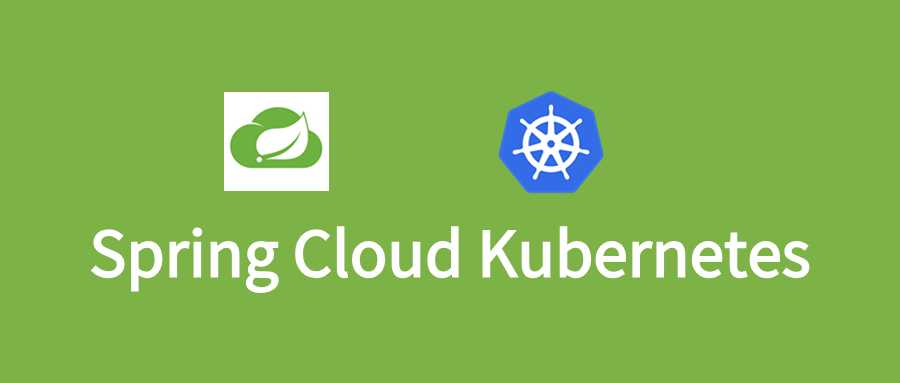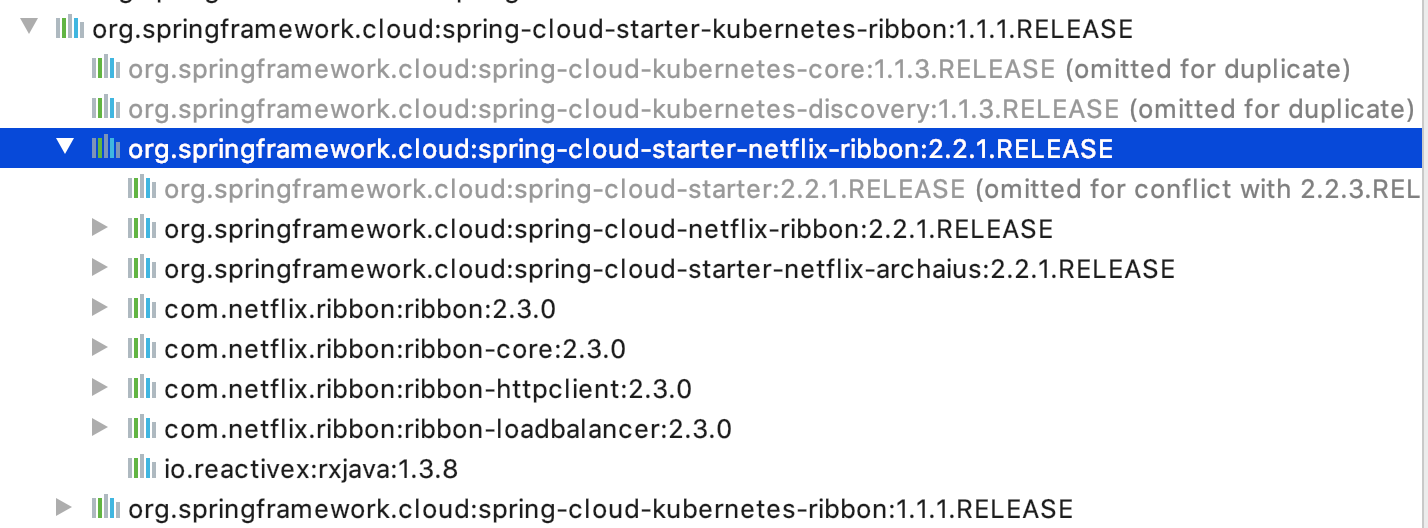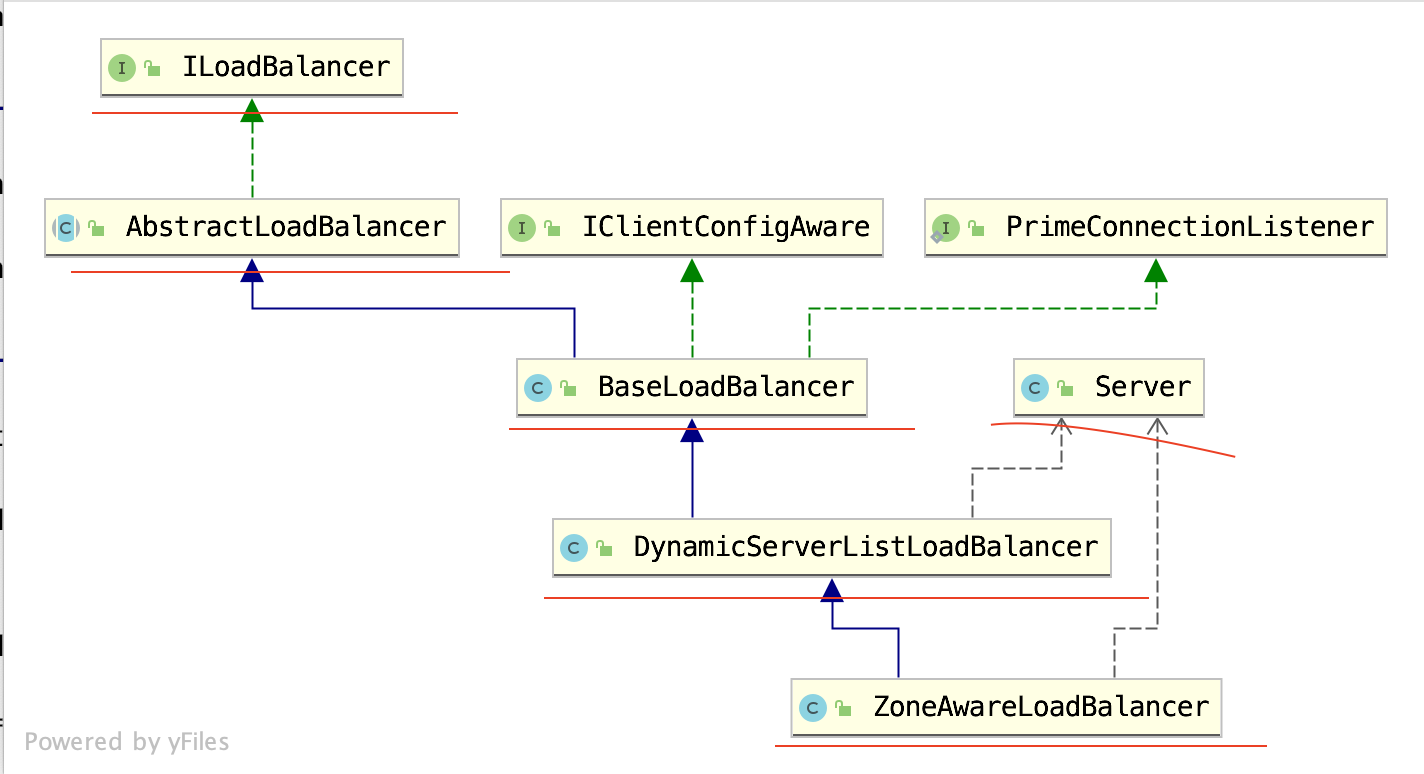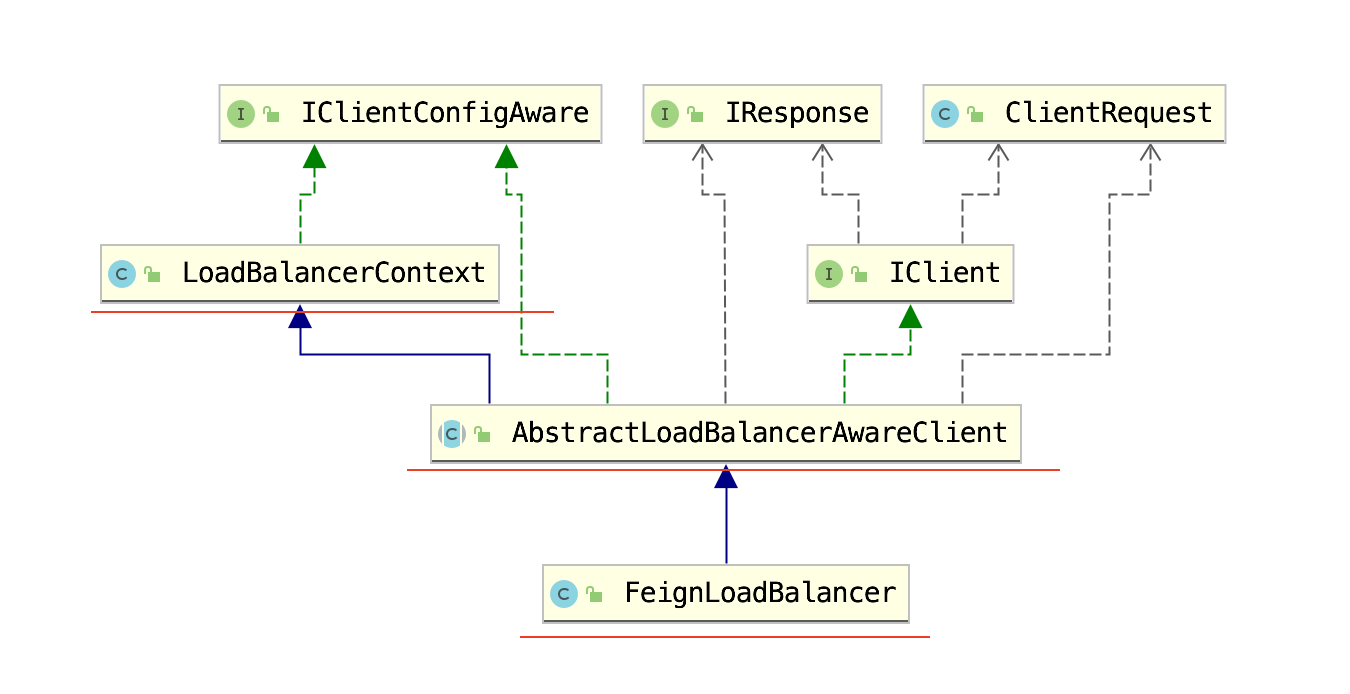
 Spring Cloud Kubernetes微服务实战与源码分析 专栏收录该内容,点击查看专栏更多内容
Spring Cloud Kubernetes微服务实战与源码分析 专栏收录该内容,点击查看专栏更多内容原创 吴就业 258 0 2020-06-27
本文为博主原创文章,未经博主允许不得转载。
本文链接:https://wujiuye.com/article/7ac94a204b934f10aee3af4387ba1ec1
作者:吴就业
链接:https://wujiuye.com/article/7ac94a204b934f10aee3af4387ba1ec1
来源:吴就业的网络日记
本文为博主原创文章,未经博主允许不得转载。
本篇文章写于2020年06月27日,从公众号|掘金|CSDN手工同步过来(博客搬家),本篇为原创文章。

在项目中使用Ribbon的目的是在客户端(服务消费端)实现负载均衡。
在上一篇《Spring Cloud OpenFeign源码分析,为什么不导入Ribbon应用会启动不起来?》中我们分析了为什么使用OpenFeign时,不配置url,且不导入Ribbon的依赖会报错。本篇继续分析OpenFeign是如何与Ribbon整合、Ribbon是如何实现负载均衡的、Ribbon是如何从注册中心获取服务的。
OpenFeign与Ribbon整合后的接口调用流程OpenFeign与Ribbon整合实现负载均衡调用接口的流程如下:
spring-cloud-openfeign-core模块:
* 1、调用LoadBalancerFeignClient的execute调用远程方法;
* 2、调用FeignLoadBalancer的executeWithLoadBalancer方法实现负载均衡调用。
ribbon-core模块:
* 3、调用LoadBalancerCommand的submit方法实现异步调用同步阻塞等待结果。
* 4、调用LoadBalancerCommand的selectServer方法从多个服务提供者中负载均衡选择一个调用;
ribbon-loadbalancer模块:
* 5、调用ILoadBalancer的chooseServer方法选择服务;
* 6、调用IRule的choose方法按某种算法选择一个服务,如随机算法、轮询算法;
OpenFeign是如何与Ribbon整合的sck-demo项目项目地址:https://github.com/wujiuye/share-projects/tree/master/sck-demo。
当我们使用openfeign时,如果不配置@FeignClient的url属性,那么就需要导入spring-cloud-starter-kubernetes-ribbon的依赖,使用LoadBalancerFeignClient调用接口。如果我们不需要使用Ribbon来实现负载均衡,那么我们可以直接将@FeignClient的url属性配置为:http://{serviceId},而不用添加Ribbon的依赖。
sck-demo项目中添加spring-cloud-starter-kubernetes-ribbon依赖,非Spring Cloud Kubernetes项目只需添加spring-cloud-starter-netflix-ribbon。
<dependency>
<groupId>org.springframework.cloud</groupId>
<artifactId>spring-cloud-starter-kubernetes-ribbon</artifactId>
</dependency>
当我们在项目中添加spring-cloud-starter-kubernetes-ribbon依赖配置时,会将spring-cloud-starter-netflix-ribbon和spring-cloud-kubernetes-ribbon都会导入到项目中,如下图所示。

当项目中使用openfeign并添加spring-cloud-starter-netflix-ribbon后,Ribbon就能通过自动配置与openfeign整合,为项目注入ILoadBalancer的实现类实例。默认使用的是ZoneAwareLoadBalancer,这是spring-cloud-netflix-ribbon下的类。
spring-cloud-netflix-ribbon的META-INF目录下的spring.factories文件内容如下:
org.springframework.boot.autoconfigure.EnableAutoConfiguration=\\
org.springframework.cloud.netflix.ribbon.RibbonAutoConfiguration
可以说spring-cloud-netflix-ribbon是spring-cloud-commons的loadbalancer接口的实现。
RibbonAutoConfiguration会注入一个LoadBalancerClient,LoadBalancerClient是spring-cloud-commons定义的负载均衡接口,RibbonLoadBalancerClient是Ribbon实现spring-cloud-commons负载均衡接口LoadBalancerClient的实现类,是提供给代码中使用@LoadBalanced注解使用的。
@Bean
@ConditionalOnMissingBean(LoadBalancerClient.class)
public LoadBalancerClient loadBalancerClient() {
return new RibbonLoadBalancerClient(springClientFactory());
}
在创建RibbonLoadBalancerClient时调用springClientFactory方法创建SpringClientFactory:
@Bean
public SpringClientFactory springClientFactory() {
SpringClientFactory factory = new SpringClientFactory();
factory.setConfigurations(this.configurations);
return factory;
}
SpringClientFactory是NamedContextFactory的子类,其构建方法调用父类构造方法时传入了一个配置类RibbonClientConfiguration.class,这是RibbonClientConfiguration配置类生效的原因。
public class SpringClientFactory extends NamedContextFactory<RibbonClientSpecification> {
static final String NAMESPACE = "ribbon";
public SpringClientFactory() {
super(RibbonClientConfiguration.class, NAMESPACE, "ribbon.client.name");
}
}
SpringClientFactory会为每个服务提供者创建一个ApplicationContext,实现bean的隔离,解决bean名称冲突问题,以及实现使用不同配置。

在创建ApplicationContext时会注册defaultConfigType到bean工厂,该defaultConfigType就是构造方法传递进来的RibbonClientConfiguration.class。
protected AnnotationConfigApplicationContext createContext(String name) {
// 创建ApplicationContext
AnnotationConfigApplicationContext context = new AnnotationConfigApplicationContext();
......
// 注册多个Configuration类
context.register(PropertyPlaceholderAutoConfiguration.class,
this.defaultConfigType);
......
// 调用ApplicationContext的refresh方法
context.refresh();
return context;
}
那createContext方法是什么时候被调用的呢?
以sck-demo中服务消费者调用服务提供者接口为例:
@Service
public class DemoInvokeServiceImpl implements DemoInvokeService {
@Resource
private DemoService demoService;
@Override
public ListGenericResponse<DemoDto> invokeDemo() {
return demoService.getServices();
}
}
DemoService是被@FeignClient注解声明的接口,当我们调用DemoService的某个方法时,经过《Spring Cloud OpenFeign源码分析》我们知道,最终会调用到LoadBalancerFeignClient的execute方法时。
public class LoadBalancerFeignClient implements Client {
//............
private SpringClientFactory clientFactory;
// 后面再分析execute方法
@Override
public Response execute(Request request, Request.Options options) throws IOException{
// .....
IClientConfig requestConfig = getClientConfig(options, clientName);
// .....
}
}
execute方法中需要调用getClientConfig方法从SpringClientFactory获取IClientConfig实例,即获取客户端配置。getClientConfig方法就是要从服务提供者的ApplicationContext工厂中获取实现了IClientConfig接口的bean。
当首次调用某个服务提供者的接口时,由于并未初始化AnnotationConfigApplicationContext,因此会先调用createContext方法创建ApplicationContext,该方法将RibbonClientConfiguration类注册到ApplicationContext,最后调用context.refresh();时就会调用到RibbonClientConfiguration的被@Bean注释的方法。
@Configuration(proxyBeanMethods = false)
@EnableConfigurationProperties
@Import({ HttpClientConfiguration.class, OkHttpRibbonConfiguration.class,
RestClientRibbonConfiguration.class, HttpClientRibbonConfiguration.class })
public class RibbonClientConfiguration {
// ........
@RibbonClientName
private String name = "client";
@Autowired
private PropertiesFactory propertiesFactory;
// IClientConfig实例,配置client的连接超时、读超时等
@Bean
@ConditionalOnMissingBean
public IClientConfig ribbonClientConfig() {
DefaultClientConfigImpl config = new DefaultClientConfigImpl();
config.loadProperties(this.name);
config.set(CommonClientConfigKey.ConnectTimeout, DEFAULT_CONNECT_TIMEOUT);
config.set(CommonClientConfigKey.ReadTimeout, DEFAULT_READ_TIMEOUT);
config.set(CommonClientConfigKey.GZipPayload, DEFAULT_GZIP_PAYLOAD);
return config;
}
// 配置Ribbon使用的负载均衡算法,默认使用ZoneAvoidanceRule
@Bean
@ConditionalOnMissingBean
public IRule ribbonRule(IClientConfig config) {
if (this.propertiesFactory.isSet(IRule.class, name)) {
return this.propertiesFactory.get(IRule.class, config, name);
}
ZoneAvoidanceRule rule = new ZoneAvoidanceRule();
rule.initWithNiwsConfig(config);
return rule;
}
// 配置服务更新器,定时从注册中心拉去服务,由ILoadBalancer启动
@Bean
@ConditionalOnMissingBean
public ServerListUpdater ribbonServerListUpdater(IClientConfig config) {
return new PollingServerListUpdater(config);
}
// 配置ribbon的负载均衡器,默认使用ZoneAwareLoadBalancer
@Bean
@ConditionalOnMissingBean
public ILoadBalancer ribbonLoadBalancer(IClientConfig config,
ServerList<Server> serverList, ServerListFilter<Server> serverListFilter,
IRule rule, IPing ping, ServerListUpdater serverListUpdater) {
if (this.propertiesFactory.isSet(ILoadBalancer.class, name)) {
return this.propertiesFactory.get(ILoadBalancer.class, config, name);
}
return new ZoneAwareLoadBalancer<>(config, rule, ping, serverList,
serverListFilter, serverListUpdater);
}
// ......其它的暂时不去理解
}
ILoadBalancer是Ribbon定义的负载均衡接口。ZoneAwareLoadBalancer是DynamicServerListLoadBalancer的子类,DynamicServerListLoadBalancer封装了服务更新逻辑。

DynamicServerListLoadBalancer在构造方法中调用enableAndInitLearnNewServersFeature方法开启服务更新器ServerListUpdater,ServerListUpdater定时从注册中心拉取可用的服务更新服务列表缓存。
public class DynamicServerListLoadBalancer<T extends Server> extends BaseLoadBalancer {
protected volatile ServerListUpdater serverListUpdater;
protected final ServerListUpdater.UpdateAction updateAction = new ServerListUpdater.UpdateAction() {
@Override
public void doUpdate() {
updateListOfServers();
}
};
public void enableAndInitLearnNewServersFeature(){
serverListUpdater.start(updateAction);
}
// 调用ServerList获取服务
@VisibleForTesting
public void updateListOfServers() {
List<T> servers = new ArrayList<T>();
if (serverListImpl != null) {
servers = serverListImpl.getUpdatedListOfServers();
// 如果需要过滤
if (filter != null) {
servers = filter.getFilteredListOfServers(servers);
}
}
updateAllServerList(servers);
}
}
Ribbon是如何实现负载均衡的ServerList我们后面再讲解,先搞清楚openfegin与ribbon整合后的整个调用链路。我们继续从LoadBalancerFeignClient的execute方法继续分析。(LoadBalancerFeignClient是由FeignRibbonClientAutoConfiguration自动配置类配置的,如果忘记的话可以再看下上一篇。)
public class LoadBalancerFeignClient implements Client {
//............
private SpringClientFactory clientFactory;
@Override
public Response execute(Request request, Request.Options options) throws IOException {
try {
URI asUri = URI.create(request.url());
// 拿到的是服务的名称,如:sck-demo-prodiver
String clientName = asUri.getHost();
URI uriWithoutHost = cleanUrl(request.url(), clientName);
// delegate是:class Default implements Client {}
FeignLoadBalancer.RibbonRequest ribbonRequest = new FeignLoadBalancer.RibbonRequest(
this.delegate, request, uriWithoutHost);
// 首先获取客户端配置
IClientConfig requestConfig = getClientConfig(options, clientName);
return
// 负载均衡选择一个服务提供者
lbClient(clientName)
// 调用接口获取响应结果
.executeWithLoadBalancer(ribbonRequest, requestConfig).toResponse();
}
catch (ClientException e) {
IOException io = findIOException(e);
if (io != null) {
throw io;
}
throw new RuntimeException(e);
}
}
}
lbClient创建一个FeignLoadBalancer对象,调用FeignLoadBalancer的executeWithLoadBalancer方法实现负载均衡调用接口,最终会调用到FeignLoadBalancer的execute方法。Ribbon使用RxJava实现异步调用转同步阻塞获取结果。
public T executeWithLoadBalancer(final S request, final IClientConfig requestConfig) throws ClientException {
// command也封装了负载均衡的实现逻辑
LoadBalancerCommand<T> command = buildLoadBalancerCommand(request, requestConfig);
try {
return command.submit(
new ServerOperation<T>() {
@Override
public Observable<T> call(Server server) {
URI finalUri = reconstructURIWithServer(server, request.getUri());
S requestForServer = (S) request.replaceUri(finalUri);
try {
// 调用FeignLoadBalancer的execute方法
return Observable.just(
AbstractLoadBalancerAwareClient.this.execute(requestForServer, requestConfig)
);
}
catch (Exception e) {
return Observable.error(e);
}
}
})
.toBlocking()
.single();
} catch (Exception e) {
.....
}
}
LoadBalancerCommand的submit方法代码比较多,逻辑也比较复杂,因此就不展开说明了。
public Observable<T> submit(final ServerOperation<T> operation) {
// Use the load balancer
Observable<T> o = (server == null ? selectServer() : Observable.just(server))
}
selectServer方法返回一个Observable<Server>,Observable是RxJava的API,我们跳过这部分。
private Observable<Server> selectServer() {
return Observable.create(new OnSubscribe<Server>() {
@Override
public void call(Subscriber<? super Server> next) {
try {
// 调用LoadBalancerContext的getServerFromLoadBalancer方法
Server server = loadBalancerContext.getServerFromLoadBalancer(loadBalancerURI, loadBalancerKey);
next.onNext(server);
next.onCompleted();
} catch (Exception e) {
next.onError(e);
}
}
});
}
selectServer方法中调用LoadBalancerContext的getServerFromLoadBalancer方法获取一个服务提供者,此LoadBalancerContext实际是FeignLoadBalancer(在buildLoadBalancerCommand方法中可以找到答案)。

getServerFromLoadBalancer方法部分代码如下:
public Server getServerFromLoadBalancer(@Nullable URI original, @Nullable Object loadBalancerKey) throws ClientException {
ILoadBalancer lb = getLoadBalancer();
if (host == null) {
if (lb != null){
Server svc = lb.chooseServer(loadBalancerKey);
return svc;
}
// .....
}
}
由于Ribbon默认使用的ILoadBalancer是ZoneAwareLoadBalancer,因此getLoadBalancer方法返回的是ZoneAwareLoadBalancer。获取到负载均衡器后调用负载均衡器的chooseServer选择一个服务提供者。

ZoneAwareLoadBalancer的chooseServer方法:
@Override
public Server chooseServer(Object key) {
if (!ENABLED.get() || getLoadBalancerStats().getAvailableZones().size() <= 1) {
logger.debug("Zone aware logic disabled or there is only one zone");
return super.chooseServer(key);
}
}
if条件成立时,调用的是父类BaseLoadBalancer的chooseServer方法:
public class BaseLoadBalancer extends AbstractLoadBalancer implements
PrimeConnections.PrimeConnectionListener, IClientConfigAware {
protected IRule rule = DEFAULT_RULE;
public Server chooseServer(Object key) {
if (counter == null) {
counter = createCounter();
}
counter.increment();
if (rule == null) {
return null;
} else {
try {
// 调用IRule的choose方法,rule是在创建ZoneAwareLoadBalancer时通过构造方法注入的
return rule.choose(key);
} catch (Exception e) {
logger.warn("LoadBalancer [{}]: Error choosing server for key {}", name, key, e);
return null;
}
}
}
}
IRule是服务选择器、是负载均衡算法的实现。在RibbonAutoConfiguration配置类中注入。
// 配置Ribbon使用的负载均衡算法,默认使用ZoneAvoidanceRule
@Bean
@ConditionalOnMissingBean
public IRule ribbonRule(IClientConfig config) {
if (this.propertiesFactory.isSet(IRule.class, name)) {
return this.propertiesFactory.get(IRule.class, config, name);
}
ZoneAvoidanceRule rule = new ZoneAvoidanceRule();
rule.initWithNiwsConfig(config);
return rule;
}
在创建ZoneAwareLoadBalancer时通过构造方法注入。
@Bean
@ConditionalOnMissingBean
public ILoadBalancer ribbonLoadBalancer(IClientConfig config,
ServerList<Server> serverList, ServerListFilter<Server> serverListFilter,
IRule rule, IPing ping, ServerListUpdater serverListUpdater) {
// ......
return new ZoneAwareLoadBalancer<>(config, rule, ping, serverList,
serverListFilter, serverListUpdater);
}
至于ZoneAvoidanceRule是怎么从多个服务提供者中选择一个调用的,这就是负载均衡算法的实现,本篇不做分析。
Ribbon是如何从注册中心获取服务提供者的前面我们分析到,ZoneAwareLoadBalancer是DynamicServerListLoadBalancer的子类,DynamicServerListLoadBalancer封装了服务更新逻辑,定时调用ServerList的getUpdatedListOfServers方法从注册中心拉取服务。
ServerList是ribbon-loadbalancer包下的类,并不是spring-cloud的接口,所以与spring-cloud的服务发现接口是没有关系的。
public interface ServerList<T extends Server> {
public List<T> getInitialListOfServers();
/**
* Return updated list of servers. This is called say every 30 secs
* (configurable) by the Loadbalancer's Ping cycle
*
*/
public List<T> getUpdatedListOfServers();
}
在分析RibbonClientConfiguration时,我们发现有一个方法会注册一个ServerList<Server>,但这个方法必不会执行到。
public class RibbonClientConfiguration {
@Bean
@ConditionalOnMissingBean
public ServerList<Server> ribbonServerList(IClientConfig config) {
if (this.propertiesFactory.isSet(ServerList.class, name)) {
return this.propertiesFactory.get(ServerList.class, config, name);
}
ConfigurationBasedServerList serverList = new ConfigurationBasedServerList();
serverList.initWithNiwsConfig(config);
return serverList;
}
}
因为我们在sck-demo项目中使用的是spring-cloud-starter-kubernetes-ribbon,所以我们现在来看下spring-cloud-kubernetes-ribbon负责做什么。首先从spring-cloud-starter-kubernetes-ribbon的spring.factories文件中找到自动配置类。
org.springframework.boot.autoconfigure.EnableAutoConfiguration=\\
org.springframework.cloud.kubernetes.ribbon.RibbonKubernetesAutoConfiguration
自动配置类RibbonKubernetesAutoConfiguration的源码如下:
@Configuration(proxyBeanMethods = false)
@EnableConfigurationProperties
@ConditionalOnBean(SpringClientFactory.class)
@ConditionalOnProperty(value = "spring.cloud.kubernetes.ribbon.enabled",matchIfMissing = true)
@AutoConfigureAfter(RibbonAutoConfiguration.class)
@RibbonClients(defaultConfiguration = KubernetesRibbonClientConfiguration.class)
public class RibbonKubernetesAutoConfiguration {
}
SpringClientFactory我们分析过了,RibbonAutoConfiguration我们也分析过了,只剩下KubernetesRibbonClientConfiguration这个配置类。
KubernetesRibbonClientConfiguration是使用@RibbonClients注解导入的配置类,也就是通过ImportBeanDefinitionRegistrar注册的。
@Configuration(proxyBeanMethods = false)
@EnableConfigurationProperties(KubernetesRibbonProperties.class)
public class KubernetesRibbonClientConfiguration {
@Bean
@ConditionalOnMissingBean
public ServerList<?> ribbonServerList(KubernetesClient client, IClientConfig config,
KubernetesRibbonProperties properties) {
KubernetesServerList serverList;
if (properties.getMode() == KubernetesRibbonMode.SERVICE) {
serverList = new KubernetesServicesServerList(client, properties);
}
else {
serverList = new KubernetesEndpointsServerList(client, properties);
}
serverList.initWithNiwsConfig(config);
return serverList;
}
}
看到这我们就明白了,spring-cloud-kubernetes-ribbon负责实现ribbon的服务列表接口ServerList<Server>。当spring.cloud.kubernetes.ribbon.mode配置为SERVICE时,使用KubernetesServicesServerList,否则使用KubernetesEndpointsServerList。默认mode是POD。
@ConfigurationProperties(prefix = "spring.cloud.kubernetes.ribbon")
public class KubernetesRibbonProperties {
/**
* Ribbon enabled,default true.
*/
private Boolean enabled = true;
/**
* {@link KubernetesRibbonMode} setting ribbon server list with ip of pod or service
* name. default value is POD.
*/
private KubernetesRibbonMode mode = KubernetesRibbonMode.POD;
/**
* cluster domain.
*/
private String clusterDomain = "cluster.local";
}
KubernetesRibbonMode是个枚举类,支持pod和service。
public enum KubernetesRibbonMode {
/**
* using pod ip and port.
*/
POD,
/**
* using kubernetes service name and port.
*/
SERVICE
}
什么意思呢? 当mode为service时,就是获取服务提供者在kubernetes中的service的名称和端口,使用这种模式会导致Ribbon的负载均衡失效,转而使用kubernetes的负载均衡。而当mode为pod时,就是获取服务提供者的pod的ip和端口,该ip是kubernetes集群的内部ip,只要服务消费者是部署在同一个kubernetes集群内就能通过pod的ip和服务提供者暴露的端口访问pod上的服务提供者。

如果我们不想使用Ribbon实现负载均衡,那么我们可以在配置文件中添加如下配置项:
spring:
cloud:
kubernetes:
ribbon:
mode: SERVICE
你学会了吗?下一篇我们了解Spring Cloud Kubernetes的服务注册。
声明:公众号、CSDN、掘金的曾用名:“Java艺术”,因此您可能看到一些早期的文章的图片有“Java艺术”的水印。

本篇分析Spring Cloud Kubernetes服务注册与发现实现原理,以及Spring Cloud Kubernetes Core&Discovery源码分析。
本篇我们再对Ribbon的重试机制地实现做详细分析,从源码分析找出我们想要地答案,即如何配置Ribbon实现调用每个服务的接口使用不一样的重试策略,如配置失败重试多少次,以及自定义重试策略RetryHandler。
本篇介绍OpenFeign与Feign的关系、Feign底层实现原理、Ribbon是什么、Ribbon底层实现原理、Ribbon是如何实现失败重试的?
如果指定了URL,那么getOptional方法不会返回null,且返回的Client是LoadBalancerFeignClient,但不会抛出异常。如果不指定URL,则走负载均衡逻辑,走的是loadBalance方法,且抛出异常。
本篇我们将从一个简单的demo上手Spring Cloud kubernetes,当然,我们只用到Spring Cloud kubernetes的服务注册与发现、配置中心模块。
订阅
订阅新文章发布通知吧,不错过精彩内容!
输入邮箱,提交后我们会给您发送一封邮件,您需点击邮件中的链接完成订阅设置。